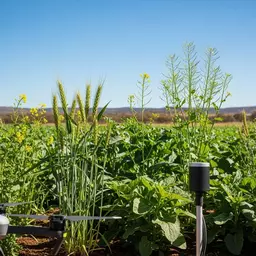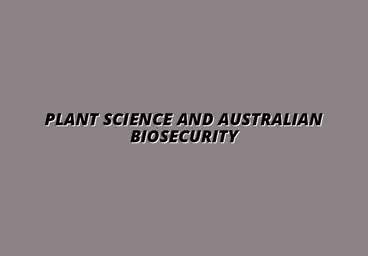Prevention & Quarantine
Strict import regulations, inspections at borders, and controlled movement of organisms are critical first lines of defense against invasive species and diseases.
What if the secret to protecting Australia’s rich agricultural heritage lies not just in farming techniques, but in a comprehensive approach to biosecurity? As we understand the delicate balance between agriculture and biodiversity, the importance of strategic measures to safeguard our ecosystems becomes increasingly clear.
Safeguarding Australia's agricultural and ecological future relies on a multi-faceted biosecurity framework. The visual below highlights the three core pillars that underpin this vital system.
Strict import regulations, inspections at borders, and controlled movement of organisms are critical first lines of defense against invasive species and diseases.
The Biosecurity Act 2015 provides a framework for proactive measures, compliance, and emergency responses, defining government's role.
Intergovernmental agreements and national strategies ensure coordinated efforts, shared resources, and public education across all stakeholders.
In the intricate world of agriculture and ecosystems, biosecurity plays a crucial role in safeguarding our natural and economic resources. But what exactly does it mean? Biosecurity encompasses a set of practices designed to prevent the introduction and spread of harmful pests, diseases, and weeds that can threaten both our agricultural productivity and the health of our environment. At Plant Frontier Insights, we recognize the significance of these measures for maintaining a sustainable agricultural future in Australia.
Biosecurity is not just a buzzword; it's a framework that supports our farmers, researchers, and policymakers in protecting Australia's unique biodiversity while ensuring our food systems remain resilient. This involves a comprehensive understanding of potential threats and the implementation of strategic interventions to mitigate them, as further detailed in resources such as the Wikipedia article on Biosecurity in Australia.
In agricultural terms, biosecurity refers to the protocols and measures that farmers implement to protect their crops and livestock from pests and diseases. These protocols can include anything from ensuring clean equipment to monitoring animal health. But biosecurity extends beyond the farm gate; it incorporates a broad spectrum of practices aimed at safeguarding ecosystems from invasive species.
Understanding these elements is vital for creating a resilient agricultural sector capable of adapting to various challenges. By fostering a culture of awareness, we can significantly reduce the risks posed by biological threats.
The importance of biosecurity cannot be overstated, especially for Australia’s agricultural exports, which contribute significantly to our economy. By implementing robust biosecurity measures, we safeguard our reputation as a provider of high-quality agricultural products. Australia's unique ecosystems also depend on these measures to maintain their health and diversity.
Ultimately, the strength of our agricultural sector and the health of our ecosystems are intertwined, making biosecurity a shared responsibility among all stakeholders, from farmers to consumers.
Quarantine is a critical aspect of biosecurity and serves as the first line of defense against invasive species. By restricting the movement of potentially harmful organisms, we can significantly reduce the risk of them establishing themselves in new environments. This preventive measure protects not only agricultural assets but also our native flora and fauna.
As we continue to navigate the complexities of biosecurity, it becomes evident that effective quarantine measures are essential for preserving Australia’s natural heritage and agricultural viability. Together, we can work towards a future where both agricultural productivity and biodiversity thrive in harmony.
How do you think we can enhance biosecurity measures in Australia? Share your thoughts below:
Understanding the role of government in biosecurity is crucial, especially in a country as vast and diverse as Australia. The government plays a pivotal role in establishing frameworks and regulations that protect our agricultural systems and natural ecosystems. At Plant Frontier Insights, we believe that these biosecurity measures not only safeguard our food supply but also promote sustainable practices across the board.
From my research, I've seen how effective policies can enhance our resilience against pests and diseases. With the right legislation and collaboration, we can build a strong foundation for biosecurity that benefits all Australians!
The Biosecurity Act 2015 is a cornerstone of Australia's biosecurity framework. This legislation was designed to streamline processes and ensure a cohesive approach to managing biosecurity risks. One of its key features is the emphasis on risk-based management, which allows for prioritization in addressing potential threats.
By understanding the intricacies of the Biosecurity Act 2015, we can appreciate the government's commitment to protecting our agriculture and ecosystems. It also highlights the importance of engaging with these policies to foster a resilient agricultural landscape.
Collaboration is at the heart of effective biosecurity measures. The Intergovernmental Agreement on Biosecurity (IGAB) is a vital framework that promotes cooperation between various levels of government—federal, state, and local. This collaborative approach ensures that biosecurity efforts are coordinated and comprehensive.
At Plant Frontier Insights, we recognize that this collaboration is essential for ensuring a robust biosecurity framework. It’s a community effort, and each of us has a role to play!
The National Biosecurity Strategy outlines the framework for achieving effective biosecurity in Australia. This strategy focuses on a holistic approach, integrating environmental, agricultural, and public health considerations. By understanding this strategy, we can see how it guides the implementation of biosecurity measures across the nation.
As we move forward, it's essential to align our practices with the National Biosecurity Strategy. By fostering collaboration and innovation, we can create a resilient agricultural future for Australia!
Biosecurity refers to a set of practices and measures designed to prevent the introduction and spread of harmful pests, diseases, and weeds that threaten agricultural productivity, ecosystems, and human health. It involves protecting both natural and economic resources.
Biosecurity is crucial for Australia to safeguard its valuable agricultural exports, which significantly contribute to the economy. It also protects Australia's unique ecosystems and endemic species from invasive species, ensuring biodiversity and environmental health.
Quarantine is a critical first line of defense in biosecurity. It involves restricting the movement of potentially harmful organisms through strict import regulations, inspections at borders, and controlled movement of plants and animals, thereby preventing invasive species from establishing in new environments.
The Biosecurity Act 2015 is a key piece of Australian legislation that provides a framework for managing biosecurity risks. It emphasizes risk-based management, proactive prevention measures, strict compliance requirements for importers and exporters, and clear protocols for emergency responses to biosecurity incidents.
The National Biosecurity Strategy is a framework that outlines Australia's holistic approach to biosecurity. It integrates environmental, agricultural, and public health considerations, focusing on objectives such as risk assessment, investment in research and innovation, and public education to create a resilient biosecurity system.
Here is a quick recap of the important points discussed in the article:

 As the agricultural landscape in Australia evolves, the role of genetic innovation tools becomes inc
As the agricultural landscape in Australia evolves, the role of genetic innovation tools becomes inc
 As the agricultural landscape in Australia faces mounting challenges, understanding effective crop p
As the agricultural landscape in Australia faces mounting challenges, understanding effective crop p
 As Australia faces growing agricultural challenges, the significance of biosecurity cannot be overst
As Australia faces growing agricultural challenges, the significance of biosecurity cannot be overst
 As we delve into the intricate world of biosecurity, consider this: the health of Australia’s ecos
As we delve into the intricate world of biosecurity, consider this: the health of Australia’s ecos